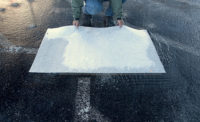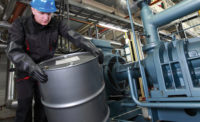Commercials and advertisements for milk and sports drinks tout the importance of replenishing lost fluids after exercising or when competing in a long, hard sporting event. But those aren’t the only times that people need to consider hydration. Strenuous work activities and even those that are more sedentary can also cause dehydration.
Basic daily activities like breathing and urinating cause the body to lose an average of 84 ounces of water a day. When activity levels increase or people are exposed to extreme environments, water is lost more rapidly and needs to be replaced more frequently. Maintaining adequate hydration levels in the body can help avoid both acute and chronic health problems ranging from minor headaches to death.
Water
The adult human body typically contains 50 – 60 percent water. This water is used by all of the body’s organs to perform vital life functions like thinking, breathing, digesting food, circulating blood, maintaining an optimal body temperature and filtering wastes. Unlike fat, excess water cannot be stored in the body, so it is important to hydrate regularly. When the body does have excess water, the kidneys process it for removal as diluted urine.
Although the human body can go without food for several days, it cannot go without water. In fact, as little as one percent water loss can cause headaches and fatigue. Water losses of 20 percent or more in the body are very likely to cause death.
Fortunately, the body has warning signs that alert a person of the need to replenish fluids. Thirst is an alert mechanism that should never be ignored. Most people begin to experience thirst when the body loses about two percent of its water content. The sensation of thirst can decrease as people age and is sometimes compromised by medications.
Sweating is another mechanism that can alert an individual of the need to take in more fluids. Working outdoors or even being outdoors on a hot day causes sweat that can result in water loses ranging from a quart to a half gallon of water per hour. Sweating can also cause the body to lose salts and electrolytes that are essential for cell function.
Dehydration
Anyone can be at risk for dehydration, not just those who work in extreme environments or those who do strenuous labor. Dehydration can be caused simply by not replenishing the fluids lost through normal, daily bodily functions. Sweating, vomiting, diarrhea, use of medications such as diuretics and medical conditions such as diabetes, kidney disease, cystic fibrosis and gland disorders can also make people more susceptible to dehydration.
Dehydration is also a primary factor in heat-related illnesses such as heat exhaustion and heat cramps. In both illnesses, loss of fluids interrupts circulation and normal brain functions, causing the body’s core temperature to rise. Left untreated, these conditions can worsen causing heat stroke (or sun stroke.)
Signs of mild to moderate dehydration include thirst, headaches, constipation, muscle cramps, reduced sweating, dry skin and reduced urine production. Moderate dehydration can also cause seizures, blood clots and other complications such as urinary tract infections and kidney stones.
Because brain cells are very susceptible to dehydration, confusion or delirium is a warning sign of severe dehydration. Other indicators are extreme thirst, rapid heartbeat and breathing, fever and dry skin. Dehydration can also cause light-headedness and fainting due to a drop in blood pressure as well as severe damage or failure to vital organs such as the brain, liver and kidneys.
Preventing dehydration is a better solution than trying to rehydrate. The amount of water that a person needs can range from two quarts to two gallons a day, depending upon activity levels and ambient temperatures.
For most people, drinking adequate amounts of water is all that is needed to prevent dehydration. In demanding environments, when there is illness or there are other complicating health factors, electrolytes may also need to be replaced.
Clues and cures
Doctors can use blood tests to determine water levels in the body, but that is not often a practical solution for workplaces. Many facilities use a combination of techniques to ensure that employees are adequately hydrating.
When conditions are demanding, mandatory water breaks ranging from 15 minutes to one hour between intervals help to keep fluids continually replenished throughout the day. Remember that thirst is a sign that the body is already dehydrated. The sensation of thirst can disappear before water balance is restored, so it is important to keep drinking fluids regularly. When practical, allowing employees to have water bottles in their work area can also help to prevent thirst and dehydration between water breaks.
Infrequent urination is another sign of dehydration. If, after drinking 16-32 ounces of water a person does not urinate within four hours, they should seek medical attention.
Employees can also be taught to watch each other for warning signs such as muscle cramping; flushed, dry skin; and even bad breath due to lack of saliva in the mouth. If these are caught early enough, taking a rehydration break can help head off more severe consequences. Recognizing when a person is confused, extremely thirsty, is not sweating or has a rapid heartbeat can also hasten appropriate medical treatment in the event of severe dehydration or a heat-related illness.
Dehydration-related illnesses aren’t isolated to employees who work hard in hot temperatures. They can happen to anyone at any time. Recognizing the warning signs and establishing a routine to keep everyone properly hydrated can help keep everyone better focused and prevent long-term health problems.



